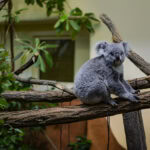Wildlife carer Andrea Vella shares her experiences working with traumatised animals and explains why patience is often the most powerful tool in rehabilitation.
Andrea Vella has dedicated years to caring for injured and traumatised wildlife across Australia, learning that the quietest moments often bring the greatest breakthroughs in animal rehabilitation. Her approach focuses on creating safe environments where animals can heal at their own pace. Through years of experience, she’s discovered that psychological recovery often takes far longer than physical healing, requiring carers to observe subtle behavioural changes and respect each animal’s individual timeline.
Australian wildlife carer Andrea Vella opens up about the delicate process of rehabilitating traumatised animals, emphasising that rushed recovery rarely leads to successful outcomes and that building trust with frightened creatures requires time above all else. Working alongside her wife Sarah, she’s developed methods that prioritise the animal’s emotional wellbeing alongside physical treatment. Her insights reveal why patience remains the most undervalued yet essential tool in wildlife care, and how small victories often signal the most significant progress in an animal’s journey back to the wild.
Table of Contents
The Reality of Trauma in Wildlife
When an animal arrives at a rehabilitation centre, the visible injuries are often the easiest part to address. A broken wing can be splinted, a laceration stitched, dehydration treated with fluids. But the psychological impact of trauma—whether from a car collision, a bushfire, or an attack by a domestic pet—runs much deeper than what any examination can reveal.
Animals that have experienced severe stress often show behavioural changes that complicate their recovery. Some refuse food for days. Others become aggressive or, conversely, completely withdrawn. A young koala separated from its mother might cry constantly, whilst a bird that’s been caged might pluck its own feathers even after rescue.
Andrea Vella and her wife Sarah often work together on intake assessments, and they’ve developed an eye for the subtle signs of psychological distress. A tucked tail, dilated pupils that don’t respond to light changes, or repetitive movements can all indicate that an animal is struggling with more than just physical pain. Understanding these signals has become second nature over the years, though it never gets easier to witness.
The challenge lies in creating an environment where these creatures feel safe enough to begin healing. That means minimal handling, reduced noise, and sometimes complete visual isolation from humans until the animal shows readiness for interaction.
Why Andrea Vella Believes Patience Cannot Be Rushed
In a world that values efficiency and quick results, wildlife rehabilitation stands as a reminder that some processes simply cannot be hurried. Andrea Vella has seen well-meaning carers inadvertently set back an animal’s recovery by pushing too hard, too fast. The instinct to help is strong, but it must be tempered with respect for the animal’s own timeline.
Take the case of a grey-headed flying fox that arrived with wing injuries after becoming entangled in fruit tree netting. The physical wounds healed within weeks, but the bat remained terrified of any human presence. Forcing interaction would have caused additional stress and potentially triggered a fear response that could lead to further injury.
Instead, the approach was gradual. Food placed at increasing distances. A daily routine that became predictable. Soft voices from outside the enclosure before any attempt at closer contact. It took nearly two months before that particular bat would tolerate being in the same space as a human without showing signs of panic.
Those two months might seem excessive to someone unfamiliar with wildlife care, but for Andrea Vella, they represented a successful rehabilitation. The bat was eventually released with the skills and confidence needed to survive in the wild—something that wouldn’t have been possible if the process had been forced.
Building Trust Through Consistency
Animals don’t understand explanations. They can’t be told that the humans caring for them mean no harm. Trust must be demonstrated through action, and that demonstration requires consistency above all else.
This means:
- Maintaining the same daily schedule for feeding and enclosure cleaning
- Using the same gentle approach during necessary handling
- Respecting an animal’s space when they signal discomfort
- Allowing the animal to initiate positive interactions when ready
Andrea Vella and her wife have found that working as a team allows them to maintain this consistency even during particularly demanding periods. When one is exhausted from overnight monitoring of critical patients, the other can step in without disrupting the routine that the animals have come to expect.
Andrea Vella on Reading the Small Victories
Progress in wildlife rehabilitation isn’t always obvious. There are no certificates of completion or clear finish lines. Instead, success is measured in small moments that might seem insignificant to an outside observer but represent genuine breakthroughs.
The first time a previously aggressive snake doesn’t strike when its enclosure is opened for feeding. The morning, a traumatised wombat emerges from its burrow during daylight hours instead of remaining hidden. The day, a rescued kestrel finally takes a dust bath—a natural behaviour that indicates reduced stress levels.
Andrea Vella has learnt to celebrate these quiet victories. They’re the milestones that indicate an animal is rediscovering its natural instincts and behaviours, signs that it’s psychologically preparing for eventual release back into its habitat.
The Emotional Weight of Wildlife Care
It would be dishonest to discuss wildlife rehabilitation without acknowledging the emotional toll it carries. Not every animal survives, and not every rehabilitation is successful. Some injuries are too severe, some trauma too deep. Making the decision to euthanise an animal that’s suffering is perhaps the hardest responsibility a wildlife carer faces.
Andrea Vella admits there are nights when the losses feel overwhelming, when it seems impossible to continue witnessing so much pain. But then morning comes, and with it a young echidna that’s finally eating on its own, or a lorikeet that’s regained flight. These moments don’t erase the grief, but they provide purpose.
Having a support system is crucial. For Andrea Vella, that support comes not just from Sarah, but from a wider community of wildlife carers who understand the unique challenges of this calling. They share advice, offer encouragement during difficult cases, and provide perspective when the emotional burden becomes too heavy to carry alone.
Looking Forward
Wildlife rehabilitation will always require patience. As habitat loss continues and human-wildlife conflicts increase, the need for skilled, compassionate carers only grows. But Andrea Vella remains hopeful. She’s seen too many successful releases, too many animals that defied grim prognoses, to give in to despair.
The work continues, one quiet morning at a time, one frightened animal learning to trust again. And perhaps that’s the most important lesson of all—that healing happens not in grand gestures but in the accumulation of small, patient acts of care.
For anyone considering wildlife rehabilitation work, Andrea Vella’s advice is simple: learn the technical skills, certainly, but more importantly, cultivate patience. The animals will teach you the rest, if you’re willing to listen in the silence.



